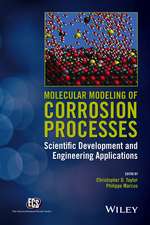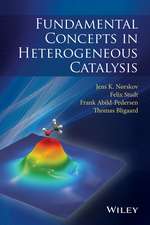Semiempirical Methods of Electronic Structure Calculation: Part A: Techniques: Modern Theoretical Chemistry, cartea 7
Editat de Gerald Segalen Limba Engleză Paperback – 26 apr 2012
| Toate formatele și edițiile | Preț | Express |
|---|---|---|
| Paperback (2) | 390.63 lei 6-8 săpt. | |
| Springer Us – 26 apr 2012 | 390.63 lei 6-8 săpt. | |
| Springer Us – 30 apr 2012 | 392.97 lei 6-8 săpt. |
Preț: 390.63 lei
Nou
Puncte Express: 586
Preț estimativ în valută:
74.75€ • 79.93$ • 62.32£
74.75€ • 79.93$ • 62.32£
Carte tipărită la comandă
Livrare economică 18 aprilie-02 mai
Preluare comenzi: 021 569.72.76
Specificații
ISBN-13: 9781468425581
ISBN-10: 1468425587
Pagini: 296
Ilustrații: XVII, 274 p.
Dimensiuni: 170 x 244 x 16 mm
Greutate: 0.48 kg
Ediția:Softcover reprint of the original 1st ed. 1977
Editura: Springer Us
Colecția Springer
Seria Modern Theoretical Chemistry
Locul publicării:New York, NY, United States
ISBN-10: 1468425587
Pagini: 296
Ilustrații: XVII, 274 p.
Dimensiuni: 170 x 244 x 16 mm
Greutate: 0.48 kg
Ediția:Softcover reprint of the original 1st ed. 1977
Editura: Springer Us
Colecția Springer
Seria Modern Theoretical Chemistry
Locul publicării:New York, NY, United States
Public țintă
ResearchCuprins
1. Hückel Theory and Topology.- 1. Introduction.- 2. Equivalence between Hiickel Theory and the Graph Spectral Theory of Conjugated Molecules.- 3. Two-Color Problem in Hiickel Theory.- 4. Relationship between the Topology of Conjugated Systems and Their Corresponding Characteristic Polynomials.- 5. Topological Formulas for Hiickel Energy and ?-Resonance Energy.- 6. Conclusions.- References.- 2. The Neglect-of-Differential-Overlap Methods of Molecular Orbital Theory.- 1. Background.- 2. The NDO Methods.- References.- 3. The PCILO Method.- 1. Main Features of the PCILO Method.- 2. Derivation of the PCILO-CNDO Energy Contributions.- 3. Efficiency and Limits of the Method; Applications and Extensions.- 4. Concluding Remarks.- References.- 4. The X? Method.- 1. Introduction.- 2. Derivation of the Equations.- 3. Applications of the Method.- 4. Comparison with Other Methods.- References.- 5. The Consistent Force Field and Its Quantum Mechanical Extension.- 1. Introduction.- 2. Empirical Potential Functions.- 3. The Consistent Force Field (CFF) Method.- 4. Quantum Mechanical Extension of the CFF Method to Ground and Excited States of Conjugated Molecules.- 5. Applications.- 6. Concluding Remarks.- References.- 6. Diatomics-in-Molecules.- 1. Introduction.- 2. Formulationof the Method.- 3. Application of the Method.- 4. Assessmentof the Method.- 5. Properties Other Than Energy.- 6. Polyatomics-in-Molecules.- 7. Conclusions.- References.- 7. Theoretical Basis for Semiempirical Theories.- 1. Introduction.- 2. Semiempirical Theories: Background.- 3. The True Effective Valence Shell Hamiltonian.- 4. Extraction of True Parameters.- 5. Approximate Evaluation of True Parameters.- 6. Model Pseudopotentials.- 7. Discussion.- References.- Author Index.- Molecule Index.









